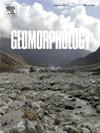Evolution of loess gullies and geohazard chains in the Dongzhi tableland, China
IF 3.1
2区 地球科学
Q2 GEOGRAPHY, PHYSICAL
引用次数: 0
Abstract
The Dongzhi tableland suffers from land degradation due to severe gully erosion. To determine the relationship between the gullies development and the evolutionary of geohazards chains in the gullies, a small watershed of the Dongzhi tableland was chosen as the study area. Subsequently, the morphometric characteristics and development process of loess gullies were systematically examined through statistical methods, including field investigations, unmanned aerial vehicle (UAV) photogrammetry, and geographic information system (GIS) spatial analysis. Results revealed that (1) The study area comprised 914 small incised gullies (SIGs), 57 incised gullies (IGs), and 5 dry gullies (DGs) based on the length, width, and depth of loess gullies. (2) SIGs were clustered and distributed at the bottom of the loess gully or on the edge of the loess tableland, and the SIG length exhibited a good power exponential relation with elevation difference, average gradient, area, and perimeter. (3) Based on the type of gully head and the degree of surface complexity, the SIGs were further divided into 27 profile types. And the most and least common profile combinations in the upper-middle-lower profiles were flat-flat-flat in 160 locations and concave-flat-stepped in one location. The corresponding results revealed loess collapse as the most dominant form of disaster during the evolution of SIGs. (4) Overall, SIG evolution was divided into four stages: initial, development, expansion, and stabilization stages. These stages mainly evolved in the form of geohazard chains and caused development of the SIGs. The results of this study will provide a scientific basis for the selection of preventive and control measures to manage gully erosion of the Dongzhi tableland.
东治塬区黄土沟壑区与地质灾害链的演化
东治塬地因沟蚀严重,土地退化严重。为确定沟壑发育与沟壑地质灾害链演化的关系,选择东直塬小流域作为研究区。随后,通过野外调查、无人机摄影测量、地理信息系统(GIS)空间分析等统计方法,系统考察了黄土沟壑区形态计量学特征及其发育过程。结果表明:(1)研究区根据黄土沟槽的长度、宽度和深度划分为小沟槽(SIGs) 914条,沟槽(IGs) 57条,干沟槽(dg) 5条。(2)团体是集群和分布式黄土冲沟的底部或在黄土高原的边缘,和团体长度表现出良好的权力指数与高差关系,平均梯度,面积和周长。(3)根据沟头类型和地表复杂程度,进一步划分出27种剖面类型。上、中、下剖面组合中最常见和最不常见的是平-平-平(160个位置)和凹-平-台阶(1个位置)。研究结果表明,黄土崩塌是sigg演化过程中最主要的灾害形式。(4)总体而言,SIG演进分为初始阶段、发展阶段、扩展阶段和稳定阶段。这些阶段主要以地质灾害链的形式演化,并导致了地质灾害链的发育。研究结果将为东直塬沟蚀防治措施的选择提供科学依据。
本文章由计算机程序翻译,如有差异,请以英文原文为准。
求助全文
约1分钟内获得全文
求助全文
来源期刊

Geomorphology
地学-地球科学综合
CiteScore
8.00
自引率
10.30%
发文量
309
审稿时长
3.4 months
期刊介绍:
Our journal''s scope includes geomorphic themes of: tectonics and regional structure; glacial processes and landforms; fluvial sequences, Quaternary environmental change and dating; fluvial processes and landforms; mass movement, slopes and periglacial processes; hillslopes and soil erosion; weathering, karst and soils; aeolian processes and landforms, coastal dunes and arid environments; coastal and marine processes, estuaries and lakes; modelling, theoretical and quantitative geomorphology; DEM, GIS and remote sensing methods and applications; hazards, applied and planetary geomorphology; and volcanics.
 求助内容:
求助内容: 应助结果提醒方式:
应助结果提醒方式:


